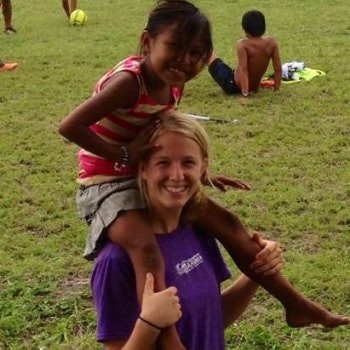When Messiah College senior Courtney Allen went to study abroad in Panama in 2013, she wasn’t concerned with earning academic credit.
“Really I wanted to get out and see the world and be able to serve people,” Allen said.
 Courtney Allen Allen said her non-credit educational activities in Panama helped better prepare her for the workforce.
Courtney Allen Allen said her non-credit educational activities in Panama helped better prepare her for the workforce.Through a campus-based organization called A Revolution of Missional Athletes, or AROMA, Allen visited Paraiso—a city just outside Panama City—where she lent her accounting skills to an organization called Rio Missions.
The Messiah softball player has since gone back to Panama every summer to do the same—relying on fund-raisers to finance her travel—and plans to do so again this summer after she graduates with a degree in accounting.
Allen represents part of what the Institute of International Education refers to in a new report released Wednesday as a growing number of students who pursue a variety of non-credit educational activities overseas.
The report, titled “The World is the New Classroom: Non-Credit Education Abroad,” found that roughly half of the 227 institutions of higher education that responded to a survey reported an increase in the number of students who participated in non-credit education abroad for the 2012-13 academic year over the previous year.
“Students have a strong interest in experiential learning outside of the traditional classroom model, and not receiving academic credit does not appear to be deterring them,” said Rajika Bhandari, deputy vice president for research and evaluation at the Institute of International Education, or IIE for short.
“The time is now for higher education institutions to have deliberate conversations about their study abroad policies and goals,” Bhandari said.
Among other things, the report recommends that colleges and universities engage student organizations and clubs—such as AROMA—as a best practice for non-credit education abroad.
The report also identified a series of factors driving the trend toward non-credit education abroad.
Specifically, colleges and universities listed increased availability of non-credit education abroad programs offered by home campuses, increased desire among students for international work experience, and the flexibility that non-credit education abroad offers students to gain international experiences without impacting their studies.
Through its Open Doors U.S. Study Abroad Survey, the Institute of International Education has been measuring students’ participation in non-credit work, internships and volunteering abroad since 2011-12 when just 116 institutions reported a total of 8,700 students.
In the 2013-14 academic year, the number had risen to 326 U.S. institutions of higher education with more than 22,000 students participating in non-credit work, internships and volunteering abroad, known as WIVA.
But the report says WIVA represents only a portion of the range of non-credit education abroad that student pursue.
U.S. students are also engaging in other types of non-credit activities overseas such as travel seminars, research, and field work, the report states.
Through the report—part of its Generation Study Abroad campaign to boost the number of students who study abroad—IIE wants colleges and universities to better track and define the range of activities that might be counted as non-credit education abroad.
“It will be critical for higher education institutions to capture the full range of students’ international educational activities, especially as colleges and universities form strategies to boost study abroad participation,” said Daniel Obst, deputy vice president for international partnerships in higher education at IIE.
The report found that 42 percent of non-credit education abroad students engaged in volunteering or service, making it the most popular non-credit activity. Other activities included travel seminars or study tours, research or field work, internships abroad, and language study.
The report found that countries in Latin America dominate as popular destinations for non-credit education abroad activities, with half of the 25 top destinations being in the region.
Latin America also attracted the largest number of volunteer and service learning students—with 79 percent—followed by Sub-Saharan Africa, which had 8 percent.
Europe led for all travel seminar or study tour students—at 41 percent—and for internship and work abroad students—at 31 percent.
Students who study abroad without credit are not the most diverse group, however. The report found that 46 percent were female and 31 percent were male, with the gender of rest being unknown due to reporting issues.
Also, 71 percent were White, while 10 percent were Hispanic and African-Americans, and Asians made up less than 4 percent each.
For Allen, the experience volunteering in Panama has led her to want to start her own nonprofit—Accounting Beyond Borders—for missionary organizations abroad.
She envisages being able to do cloud accounting remotely from here in the United States but would also make at least one trip to each client organization per year in order to get a better feel for the organization’s mission.
Allen also has a job lined up at a CPA firm outside Philadelphia. She is set to begin in August after her return from Panama. She credits her experience with better preparing her for her job.
“I’ve learned a lot of skills like thinking critically through situations and coming up with my own kind of accounting system,” Allen said. “I’ve learned that, for accounting, you have to know who you’re working for and learn the organization well so you can serve them well.”
Jamaal Abdul-Alim can be reached at [email protected] or follow him on Twitter @dcwriter360.




![Mentor Mentee [60287]](https://img.diverseeducation.com/files/base/diverse/all/image/2024/04/Mentor_mentee__60287_.662959db8fddb.png?auto=format%2Ccompress&fit=crop&h=100&q=70&w=100)
















